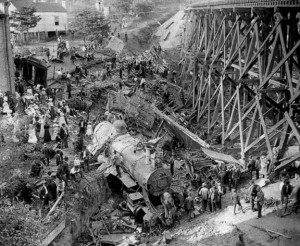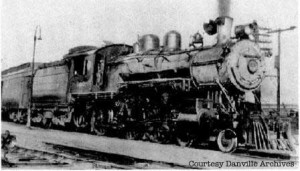The Flight of the Midnight Mail, 1905
From the time of its opening, Terminal Station thrummed like a beating heart day and night, shuttling 80 trains and 10,000 passengers a day on its 12 tracks and boasting a depot equal in size to that of Grand Central Station [1]. In addition to its steadily-increasing volume of passengers, baggage, and freight, Terminal station moved mail, and it moved it fast. The phenomenon of the midnight mail deliveries became legend in 1905, popularized by thrill-seeking newspaper reporters who wrote of their rides in the engines of trains reaching “cyclonic” speeds of 70 miles an hour, streaking through the night to make sure the nation’s mail arrived on time [2].
By 1922 Terminal Station’s basement post office had become the third largest Government Railway Post Office in the country, employing 125 people and distributing mail throughout the Southeastern United States[3]. The Southern Railway ran a mail route between Atlanta and Montgomery, 175 miles of track that was normally run at a schedule of four hours and two minutes. When the mail arrived late from its previous stop, however, the engineers of No. 97, the Crescent Limited out of Atlanta, would work their steam engines to the bone, and often could make it in three hours flat to avoid the hundred-dollar fee from the government, which would be charged to the railway should the mail be over five minutes late[4].
In the early years of this mail service, the entire nation was fascinated by the “fast mail.” Southern Railway’s “Old 97” was considered the fastest train in the country when it was manufactured in 1903, and for less than a year it pulled mail from Washington, DC to Atlanta. On September 27, 1903, the mail arrived in Monroe, Virginia 47 minutes late. While speeding to make up time between Monroe and Spencer, North Carolina, the train derailed and plunged off a trestle into a ravine below, killing eleven passengers and injuring the remaining seven[5]. The ballad “Wreck of the Old 97” immortalized the event and has since been covered by Johnny Cash, Hank Williams III, Woodie Guthrie and countless others (listen below to an earlier version by Pink Anderson).

Glass plate negative of the wreck of the Old 97, two days later after the engine had been turned upright. DCS Films
This excitement around the Old 97 came to a height in 1905, the year Terminal Station opened. Roscoe Gorman, a reporter for the Atlanta Constitution, contributed to the hype by riding along in No. 97, which had been rebuilt following the accident, on a stretch from Atlanta to Montgomery. His article paints a picture of mayhem in the station, clerks throwing sacks of mail in and out of the cars in the glow of the engine’s furnace, and heroic feats of engineering as Engineer McDonald coaxed his train to a speed of “5,280 feet every fifty-two seconds and [held] it there for hours”[6]. Another Atlanta reporter accompanying McDonald wrote that the engine “began to sway like a ship in a heavy storm […] then I knew the race against time was on.” Rattling along at “cyclonic” speeds up to 72 miles per hour, the train ride was described as “the excitement of battle and sudden death; battles with grades and curves and the death of seconds […] in the making up of the lost time”[7]. These railroad engineers were thought of in 1905 as we think of astronauts and test fighter pilots today: charging bravely into the unknown at high speed, calmly in command of the engineering marvels of our time and performing feats we have barely dreamed of. These heroes of the midnight mail gave Atlanta something to be proud of, and something for the thousands of people passing through Terminal Station to talk about.
The Wreck of the Old 97, by Pink Anderson
—
[1] Wilson Burke, “Terminal Station Open Today, A Thing of Beauty,” Atlanta Journal, May 14 1905, Atlanta History Center, Terminal Station Subject File.
[2] Roscoe Gorman, “The Flight of the Midnight Mail,” Flight of the Midnight Mail, (Atlanta: Atlanta and West Point Rail Company, 1930).
[3] John R. Hornady, Atlanta Yesterday, Today and Tomorrow (n.p.: American Cities Book Company, 1922), p. 331.
[4] Roscoe Gorman, “The Flight of the Midnight Mail,” Flight of the Midnight Mail, (Atlanta: Atlanta and West Point Rail Company, 1930).
[5] Lance Phillips,Yonder Comes The Train: The story of the Iron Horse and some of the Roads it Traveled (New York: A.S.Barnes and Co,1965), 371
[6] Edwin Johnson, “We Made the Mail with a Minute to Spare!” Flight of the Midnight Mail, (Atlanta: Atlanta and West Point Rail Company, 1930).
[7] Alan Rogers, “How Engineer McWaters Murdered the Lost Hour,” Flight of the Midnight Mail, (Atlanta: Atlanta and West Point Rail Company, 1930).



